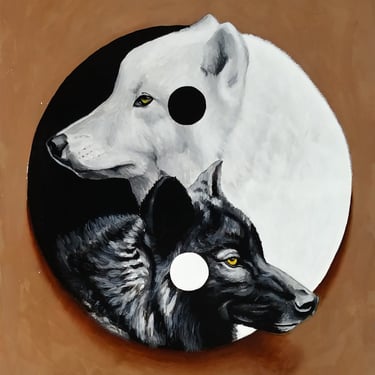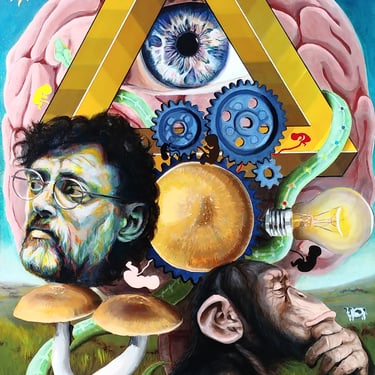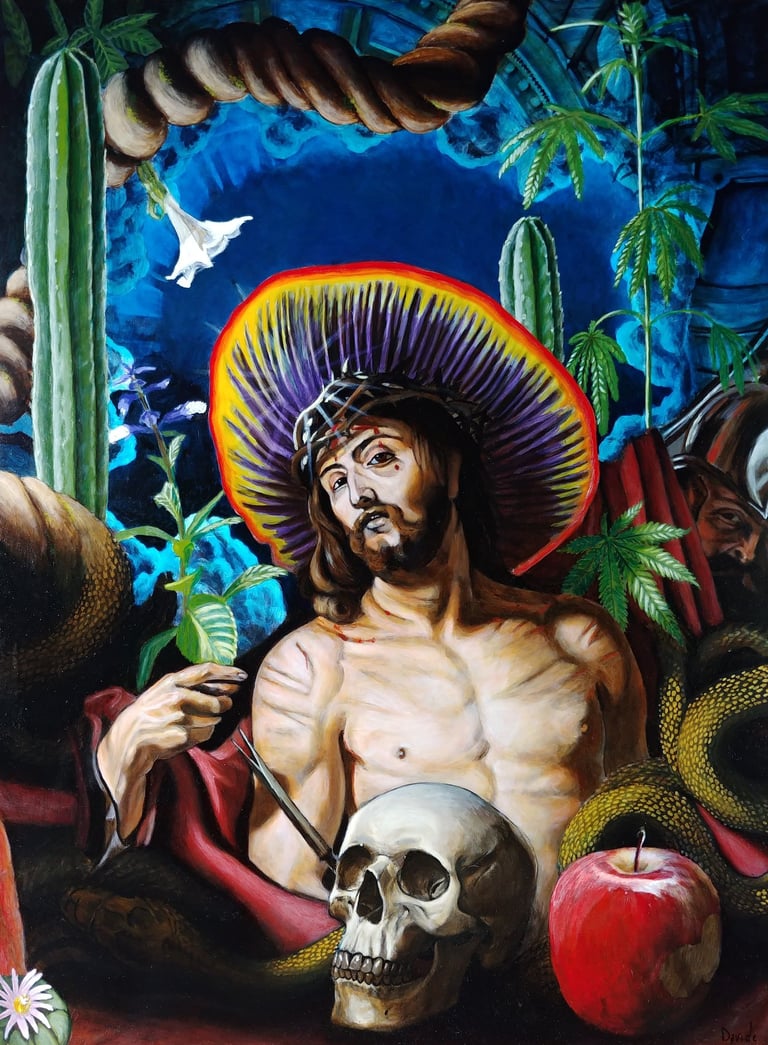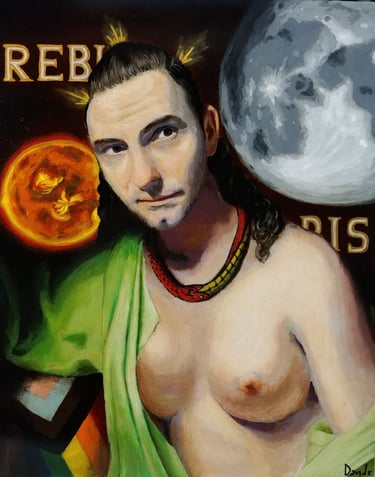





Cryptical Paintings: Exploring Intricate Concepts through Art by Davide Granata Liberty
Welcome to the Cryptical Paintings gallery, where Davide Granata Liberty explores intricate concepts through his art. While Davide generally prefers not to explain his paintings, in this section, he provides some context to enhance your viewing experience. Here, you will find detailed information on the inspiration behind each piece, allowing you to gain deeper insight into Davide's creative process. Enjoy exploring this unique and thought-provoking collection


ECCE HOMO
24x32 Oil Painting on Panel
"Ecce Homo" is a profound artwork that delves into the complex interplay between human nature and divinity. The title, derived from Pilate's declaration, "Behold the man," emphasizes the initial lack of recognition by society of the divine essence within each individual.
Drawing upon anthropological studies, the painting explores the historical utilization of entheogens in various ancient cultures for religious, magical, shamanic, and spiritual purposes. Notably, it highlights the promising advancements in the field of psychedelic studies through organizations such as MAPS (Multidisciplinary Association for Psychedelic Studies), which have reoriented the use of these substances toward healing.
Within this enigmatic composition, Christ symbolizes the inherent potential within every person to realize their own divinity. The presence of the skull, known as Golgotha in Aramaic, serves as a poignant emblem of our transient existence and mortality. Furthermore, the depiction of the bitten apple alludes not only to the concept of original sin but also to the recognition of our imperfections and limitations. The image of the scourged Christ signifies that personal growth often necessitates enduring arduous trials that leave indelible scars.
The painting incorporates a diverse array of psychedelic plants, strategically employed to facilitate the acknowledgment of our inherent divine nature. Among these are Peyote, San Pedro, Salvia divinorum, Marijuana, Datura, a Psilocybe cap positioned above Jesus's head, a sacred snake metamorphosing into an Ayahuasca vine, and various Psychotria Viridis plants. These botanical elements serve as catalysts for the realization of one's true essence.
Intriguingly, the composition reveals a hidden figure in the background, subtly observing the unfolding events. This anonymous witness serves as a testament to the ultimate truth that humanity is genuinely divine, further reinforcing the central theme of the artwork.


THE STONED APE THEORY
30x36 Oil Painting on Canvas.
"The Stoned Ape Theory" is a thought-provoking painting that explores the evolutionary concept introduced by Terrence McKenna. This theory postulates that the transformation of apes into modern humans was a result of their exposure to psilocybe mushrooms.
Within the natural world, each species possesses specific dietary preferences, which serve as a protective mechanism against mutagens and inherited DNA damage. Remarkably, primates display a unique behavioral characteristic of exploring alternative food sources when faced with starvation, an inclination not commonly observed in other species.
According to the Stoned Ape Theory, the changing environmental conditions compelled apes to venture into grasslands in search of sustenance, leading them to encounter the ancestors of cows. Psilocybe mushrooms, known to grow on cow manure, became a part of the apes' diet. Observations of baboons flipping cow dung to procure pupae provide evidence of this behavior.
The ingestion of psilocybe mushrooms elicits various effects, which are dependent on the dosage. Lower doses are believed to enhance visual acuity, thereby facilitating improved foraging abilities and predator avoidance. Slightly higher doses induce arousal, thereby increasing the likelihood of successful reproduction. At higher doses, the psychedelic compounds in the mushrooms are known to induce mind-altering and mystical experiences.
Consequently, the Stoned Ape Theory suggests that the apes consuming psilocybe mushrooms not only gained a survival advantage but also experienced heightened brain stimulation and a more diverse diet. Over the course of millennia, these factors contributed to the evolution of apes into modern humans.
This painting depicts a grassland setting, with the prominent presence of the psilocybe mushroom. Symbolically, a gear-mushroom hybrid image signifies the transitional phase and the parties involved in this evolutionary exchange. Additionally, a light bulb serves as a representation of the newfound intellectual and conceptual capacities of the evolving mind. The human figure portrayed in the painting is Terrence McKenna himself, a key proponent of the Stoned Ape Theory. A snake adorned with the numbers 33 and seven colorful dots represents the concept of kundalini rising, with 33 symbolizing the vertebrae and the seven dots alluding to the chakras. Furthermore, the painting incorporates six fetuses, symbolizing the increased chances of successful reproduction, with the number six being associated with the creation of mankind on the sixth day according to biblical accounts. Positioned in the upper section of the artwork, the central focus is on the brain, representative of the defining aspect of humanity, along with imagery such as the all-seeing eye of God, the impossible triangle, and the sun and moon as representations of masculine and feminine energies.


2023 A MODERN DAY SELF PORTRAIT
16x20 Oil Painting on Panel
"2023: A Modern Day Self Portrait" is a compelling artwork that serves as a respectful critique of contemporary society while delving into the artist's personal doubts. The painting reflects a nuanced exploration of the consequences of impulsive decision-making prevalent in our times, without opposing individual choices outright.
As a caring father, the artist emphasizes the importance of considering the ramifications of our actions and recognizing that true fulfillment originates from within. Drawing a parallel between alchemical symbolism and present-day choices, the artwork invites contemplation.
The central figure prominently embodies the concept of hermaphroditism, symbolizing the fusion of both male and female energies. This depiction resonates with the alchemical notion of achieving completeness, often referred to as the Opus Magnum. The garment worn by the figure is green, a color associated with hope. It represents the artist's aspiration for humanity to navigate away from misguided decisions, urging a more thoughtful approach.
In the background, the Sun and the Moon act as potent symbols representing masculine and feminine energies respectively. The artist's doubts manifest through the portrayal of an exaggeratedly proportioned moon, illustrating the potential emotional influence on our decision-making processes. Additionally, the word "REBIS," derived from Latin and signifying "dual" or "double matter," emerges but remains concealed by the figure. This term represents the ultimate outcome of the alchemical Great Work, and its partial visibility alludes to the enigmatic nature of personal transformation.
Supporting the figure at the bottom of the painting is the inclusion pride flag, a recognizable symbol representing inclusivity and acceptance. The hermaphrodite is adorned with an ouroboros snake necklace, further hinting at the concept of wholeness and self-sufficiency.
This self-portrait encapsulates the artist's self-doubts while simultaneously conveying the understanding that the integration of opposing energies is essential for attaining personal perfection. It invites viewers to reflect upon the complexities of decision-making in the modern era and the pursuit of balance and unity within oneself.
WHICH WOLF WILL YOU FEED?
16x20 Oil Painting on Panel
"Which Wolf Will You Feed" is a compelling painting that serves as a visually captivating representation of the timeless question confronting humanity. This question metaphorically explores the dichotomy between the forces of good and evil that reside within each individual. The artwork prominently features two wolves, one black and one white, seamlessly merged into the symbol of the Tao, evoking a sense of profound symbolism and meaning.
The contrasting wolves symbolize the opposing forces of good and evil, with the black wolf embodying negative traits such as anger, greed, and envy, while the white wolf represents positive attributes such as kindness, compassion, and love. The Tao, depicted in the painting, signifies the delicate equilibrium between these opposing forces, emphasizing the crucial significance of balance and harmony in life.
Intricately intertwined in a yin-yang fashion, the two wolves serve as a visual reminder that the existence of one force is inseparable from the other. The painting seeks to capture the inherent duality of human nature, prompting viewers to introspect and consider which wolf they choose to nourish and nurture in their own lives.
This artwork provokes thought and invites contemplation about the choices we make and the paths we follow. It encourages individuals to reflect on their actions and decisions, urging them to strive for equilibrium and embrace the positive aspects of their character. "Which Wolf Will You Feed" serves as a powerful reminder of the timeless pursuit of balance and harmony within the human experience.


